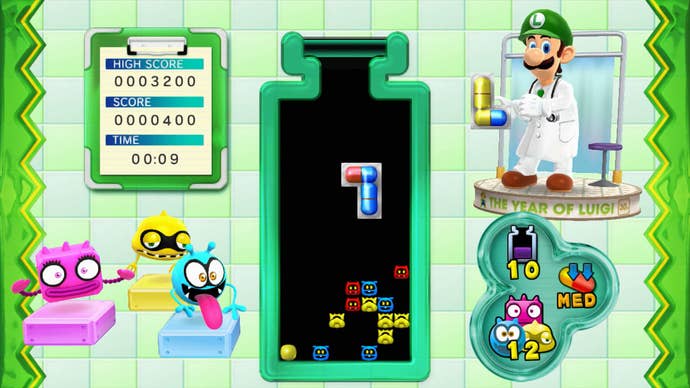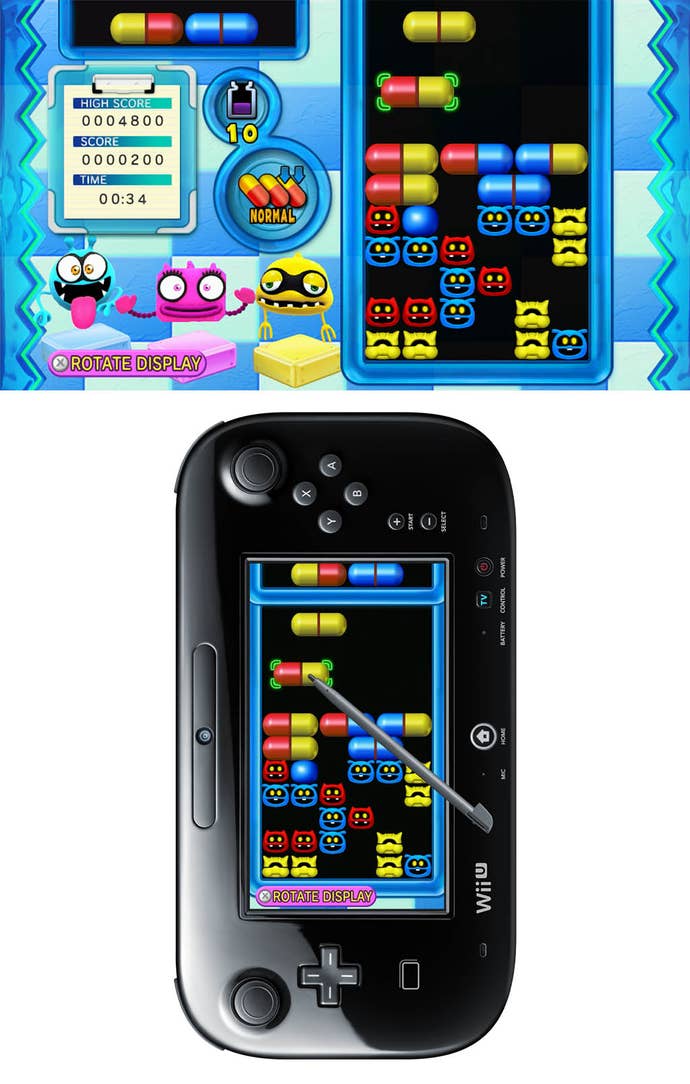Dr. Luigi Wii U Review: Practitioner Imperfect
Not quite the viral hit you might be hoping for.
This article first appeared on USgamer, a partner publication of VG247. Some content, such as this article, has been migrated to VG247 for posterity after USgamer's closure - but it has not been edited or further vetted by the VG247 team.
There's something quietly tragic about Dr. Luigi. I haven't quite pinned down the source of the tragedy yet, but I think it may be the little "YEAR OF LUIGI" pedestal the titular character stands on throughout the entirety of the game.
As if it's not enough that Luigi's new game is just a hack of his brother's 8-bit puzzler, he spends the whole time proclaiming his greatness. It smacks of false bravado, as if Luigi feels that if he crows about his greatness maybe he'll eventually start believing it. Besides, let's be honest: As far as falling-block puzzle games go, Dr. Mario was no great shakes. It came about from Nintendo's eagerness to capitalize on the success of Tetris by building a wholly original creation around its own characters, but the results proved to be pretty tepid. Pills fall, you flip them, there are some simple chaining and falling mechanics; repeat until you lose or, more likely, you lose interest.
Dr. Mario lacks the intensity of a Tetris or the complexity of a Puyo Puyo, falling into a humdrum middle ground. Dr. Luigi throws some new mechanics into the mix, but they only serve the exacerbate the source material's central failing: The primary new mode, Operation L, makes the central game even slower and less intense. Here, pills drop only in an L formation consisting of two normal pills linked together for a total of four blocks of color. This actually makes it a little more like Tetris, where every piece contains four small squares, but it's a strange form of Tetris where only L-blocks exist. To make things even more limited, the "backbone" of the L-shaped pill formations is always a single color; only the "foot" of the L has the potential to vary in color from the other capsule halves.

These new rules work in tandem to make the game feel far slower and more unwieldy than classic Dr. Mario. The pills are much harder to maneuver into tight spots than the single capsules of Dr. Mario, and the fact that you always have three blocks of the same color appearing in a line means there's little challenge in simply clearing viruses away. Where solid-colored pills were a precious resource in the original game, the equivalent of a Tetris I-block, here no piece has any particular value over the other, and emptying the screen is a cinch.
That isn't to say Operation L isn't without merit. It's still a decent puzzler, and the new pill configuration forces you to adopt completely new strategies. Lateral clears and chained virus-busting combos play a much larger role, and you're less able to rely on sneaking pills into the lower regions of the screen. Because twice as many blocks are falling at a time, things become cluttered more quickly, and a misjudged drop can easily make a disaster of things. It's a different way to play Dr. Mario -- not better, but not radically worse, either. Just... different.

For those who crave the same-old same-old, Dr. Luigi does include the option to play a reskinned version of classic Dr. Mario (after a few hours of Dr. Luigi's pokey pace, the original game feels almost unmanageably fast). You can also go the other direction and play a mode called Virus Buster, a completely stylus-driven mode in which pills fall with almost agonizing slowness until you hit level 20 or so -- though this turns out to be a boon, as the longer you play the more pills fall at once. Eventually you're managing three falling pills at a time, tapping and dragging them into place, and the whole thing becomes pleasantly frantic.
Really, though, Dr. Luigi sells itself almost entirely on novelty. It's an amusing wrinkle on a familiar favorite, even if it ultimately proves to be as middling as the source material. The fun little riffs on classic material (like Virus Buster's pleasantly chill renditions of Dr. Mario's tunes) help sustain interest after the initial smirk has faded, and the numerous gameplay variations (including online play) certainly keep things lively longer than the spartan feature set of the original Dr. Mario did.
ConclusionIt's still a far cry from the top-tier classic puzzlers, but Dr. Luigi manages to be fun enough... even if there is that nebulous whiff of tragedy about the whole affair. On the other hand, it doesn't leave the nasty taste in your mouth that you get from exploitatively designed free-to-play puzzlers like Candy Crush Saga, so that's something.








